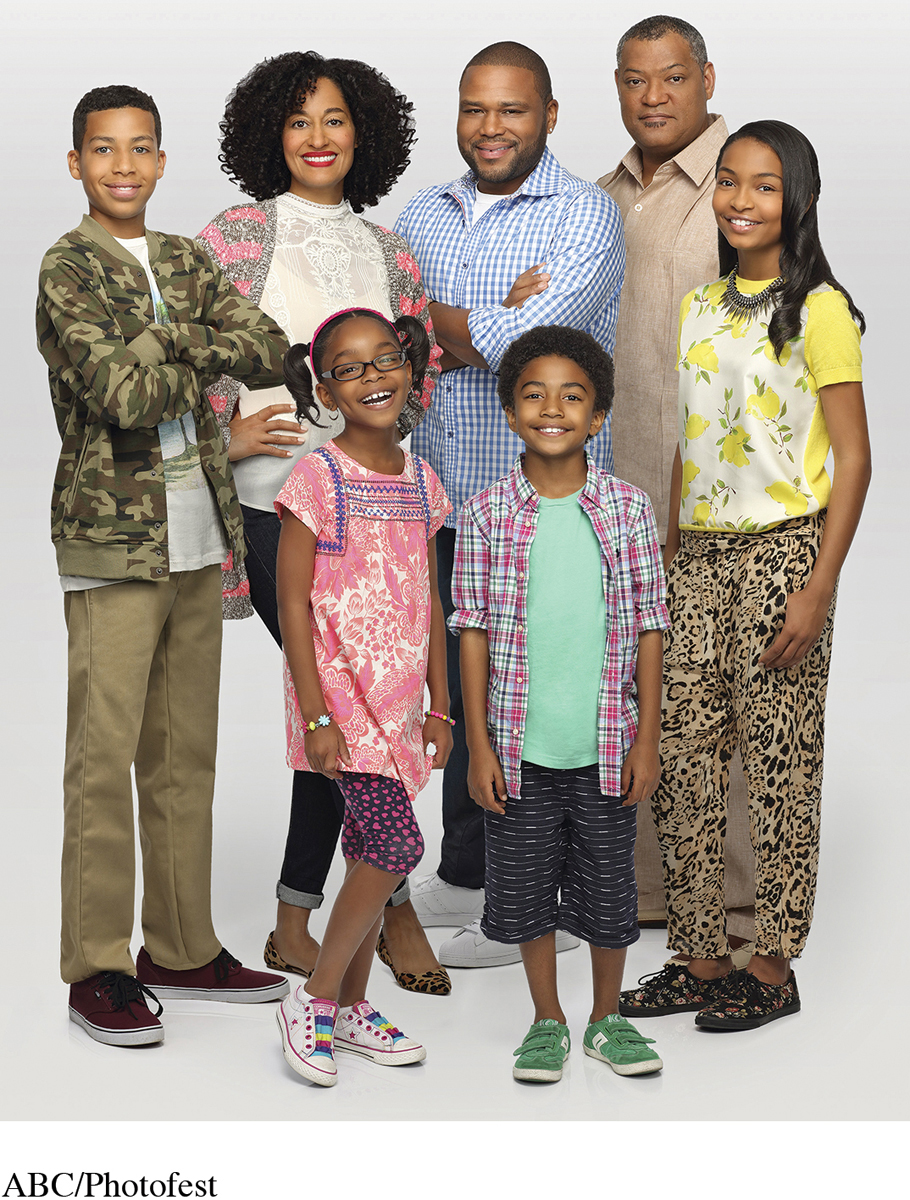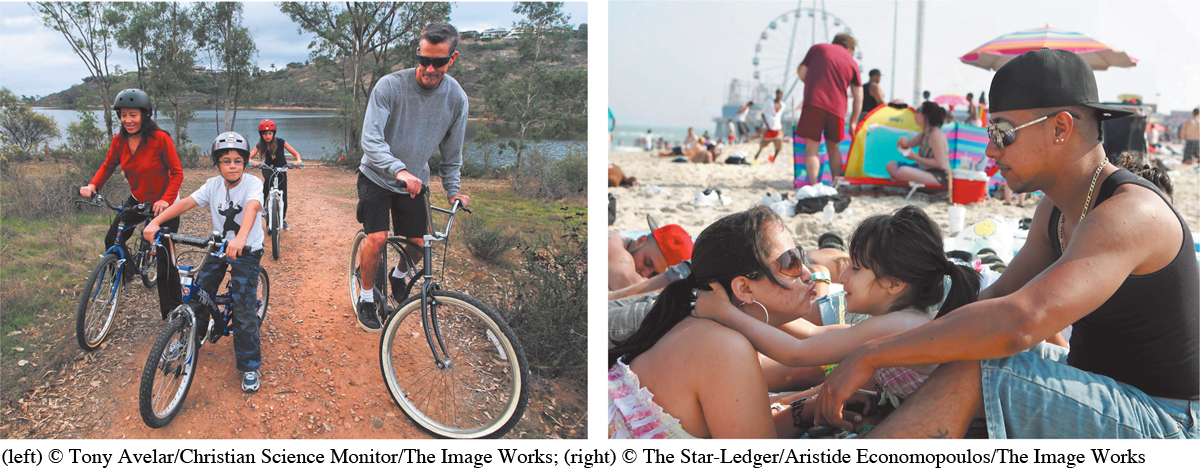Defining Family
When many of us think of family, iconic TV images come to mind, like the Johnsons in Black-ish or the Dunphys from Modern Family. These images are simple and comforting: families consist of happily married couples raising their biological children, bonded by love and united in facing any challenges that confront them (Braithwaite et al., 2010).
But families today are more diverse than such depictions suggest. Between 1970 and 2010, the percentage of households composed of married couples with biological children in the United States declined from 40 percent to just 20 percent (Tavernise, 2011). In Canada, this kind of family declined from 55 percent in 1981 to 39.2 percent in 2011 (Statistics of Canada, 2012). Instead, couples are increasingly living together rather than getting married, making marriage less common than at any prior time in history (Cherlin, 2004). Rising divorce rates over the past half century have also decreased the average size of households, as families divide into smaller units and re-form into blended arrangements featuring stepparents and stepchildren. Adding to this complexity, individual families are constantly in flux, as children move out, then lose jobs and move back in with parents; grandparents join the household to help with day care or receive care themselves; and spouses separate geographically to pursue job opportunities (Crosnoe & Cavanagh, 2010).

DEFINING CHARACTERISTICS OF FAMILY
The enormous diversity in contemporary families requires a broad, inclusive definition. Family is a network of people who share their lives over long periods of time and are bound by marriage, blood, or commitment; who consider themselves as family; and who share a significant history and anticipated future of functioning in a family relationship (Galvin, Brommel, & Bylund, 2004). This definition highlights six characteristics that distinguish families from other social groups.
First, families possess a strong sense of family identity, created by how they communicate (Braithwaite et al., 2010). The way you talk with family members, the stories you exchange, and even the manner in which members of your family deal with conflict all contribute to a shared sense of what your family is like (Tovares, 2010).
Second, families use communication to define boundaries, both inside the family and to distinguish family members from outsiders (Afifi, 2003; Koerner & Fitzpatrick, 2006). As we’ll discuss later, some families constrict information that flows out (“Don’t talk about our family problems with anyone else”). Some also restrict physical access to the family—for example, by dictating with whom family members can become romantically involved (“No son of mine is going to marry a Protestant!”). Others set few such boundaries: a family may welcome friends and neighbors as unofficial members, such as an “uncle” or “aunt” who isn’t really related to your parents (Braithwaite et al., 2010). For instance, my sons grew up knowing and referring to our good friend Tim Levine as “Uncle Tim,” even though he isn’t a blood relation. A family may even welcome others’ children, such as the neighbors across the street whom you think of as your “family away from home.” If remarriage occurs and stepfamilies form, these boundaries are renegotiated (Golish, 2003).
self-reflection
With whom do you share more intense emotional bonds: family members, friends, lovers, or coworkers? Do you always feel positively toward your family, or do some members consistently trigger negative emotions in you? What does this tell you about the intensity and complexity of emotional bonds in family relationships?
Third, the emotional bonds underlying family relationships are intense and complex. Family members typically hold both warm and antagonistic feelings toward one another (Silverstein & Giarrusso, 2010). As author Lillian Rubin (1996) notes, family relationships have “an elemental quality that touches the deepest layers of our inner life and stirs our most primitive emotional responses” (p. 256). Consider the strength of feeling that arises in you when you get into an argument with a parent or sibling, or when you celebrate an important milestone (a graduation, a wedding, a new job) with family members.

Fourth, families share a history (Galvin et al., 2004). Such histories can stretch back for generations and feature family members from a broad array of cultures. These histories often set expectations regarding how family members should behave (“We Ngatas have always been an honest bunch, and we’re not about to change that now”). Families also share a common future: they expect to maintain their bonds indefinitely. For better or worse, everything you say and do becomes a part of your family history, shaping future interactions and determining whether your family relationships are healthy or destructive.
Fifth, family members may share genetic material (Crosnoe & Cavanagh, 2010). This can lead to shared physical characteristics as well as similar personalities, outlooks on life, mental abilities, and ways of relating to others. For example, some studies suggest that interpersonal inclinations such as shyness and aggressiveness are influenced by genes (Carducci & Zimbardo, 1995).
Finally, family members constantly juggle multiple and sometimes competing roles (Silverstein & Giarrusso, 2010). Within your family, you’re not just a daughter or son, but perhaps a sibling, a spouse, or an aunt or uncle as well. By the time you reach middle age, you may simultaneously be a parent, spouse, grandparent, daughter or son, and sibling—and each of these roles carries with it varying expectations and demands. This makes communicating competently within families challenging.
TYPES OF FAMILIES
No “typical” family type exists. Instead, families come in many different forms (Braithwaite et al., 2010). But even these forms are not fixed: you may experience several different family structures as you progress through life and as our larger society evolves. For example, 60 years ago, the nuclear family—a wife, a husband, and their biological or adopted children—was the most common family type in North America. Today, it is in the minority. Instead, families may include children or not; have one parent or two; be headed by heterosexual, lesbian, gay, bisexual, or transgendered people; include other relatives, such as grandparents; include stepparents and stepsiblings; or consist of any other combination you can imagine! While we discuss the family types further, consider how your family experiences align with or depart from these depictions. But perhaps most importantly, keep this in mind: what matters most is not the “type” of family you have but whom you consider part of your family in terms of love, respect, and communication.

When relatives such as aunts, uncles, parents, children, and grandparents live together in a common household, the result is an extended family. By the year 2050, 100 million people in the United States will be over the age of 65, and many of these individuals will be sharing a household with relatives. Numerous Italian American, African American, and Asian American families fall into this category.
Approximately half of marriages in the United States and Canada are remarriages for one or both partners (Coleman, Ganong, & Fine, 2000). This often creates a stepfamily in which at least one of the adults has a child or children from a previous relationship (Ganong & Coleman, 1994). Stepfamilies are often called “blended” or “remarried” families. More than 50 percent of children born throughout the twenty-first century will grow up in stepfamilies (Crosnoe & Cavanagh, 2010).
self-reflection
What type of family did you grow up with? What makes you collectively a family—the fact that you are biologically related? live in the same household? share a strong emotional bond? Now think about other people’s families. Are there those that consider themselves families that you don’t? If so, why?
Some couples live together prior to or instead of marriage. These cohabiting couples consist of two unmarried, romantically involved adults living together in a household, with or without children. Cohabitation is steadily increasing in Western societies (Adams, 2004). This is partly due to an increase in cohabitation among middle-aged and older adults, many of whom were formerly married but now want the relational flexibility that cohabitation affords (Silverstein & Giarrusso, 2010).
In a single-parent family, only one adult resides in the household, possessing sole responsibility as caregiver for the children. As of 2011, 27 percent of children in the United States (U.S. Census Bureau, 2011) and about 19 percent of children in Canada (Statistics Canada, 2012) were growing up in single-parent households.
A final family type is the voluntary kin family: a group of people who lack blood and legal kinship but who nevertheless consider themselves “family.” Oftentimes such families arise from distance, dissatisfaction with, or estrangement from blood and legal relatives. In such cases, three types of voluntary kin families arise (Braithwaite et al., 2010). The most frequent form is the supplemental family, in which dissatisfaction with family relationships leads people to begin labeling other close people in their lives as “family,” even though they retain contact with their blood and legal relatives. For example, my college girlfriend, Michelle, developed close relationships with my parents while we were dating—even closer than her own family—and consequently starting calling my parents “Mom” and “Dad,” and talking about my family as “her second family.” In contrast, people who create a substitute family have no contact whatsoever with blood or legal relatives—either because of estrangement or death—and replace their relatives entirely with a group of individuals considered to be “family.” Finally, within a convenience family, people may, for a particular time span, come to think of a group of people as their “family,” although the ties between them are temporary. For instance, students who study abroad may live in a household in which the residents become “family” for that time period, only to have the relationships splinter after everyone returns home. The same thing may happen within institutionalized settings—for example, during lengthy stays in rehab—when people in an intensive, residential counseling facility bond together, only to have those ties fray upon completion of the therapy.